‘American Born Chinese’ Author Gene Luen Yang Talks Winning a MacArthur and Adapting ‘Clash of Clans’

Gene Luen Yang, author of American Born Chinese, Boxers and Saints, and many other works, is one of the most beloved graphic novelists of our time. Now, while Disney’s American Born Chinese live-action adaptation streams on Disney+, Yang is working on an adaptation of his own: an eight-volume series of graphic novels, The Books of Clash, based on Clash of Clans, the mobile game about warring villages. It’s a departure from some of Yang’s early work, but it still bares his signature style.
We sat down with Yang at San Diego Comic-Con 2023 to ask him about his career and his latest work.
What drew you to adapting Clash of Clans?
I first heard about the Clash of Clans game maybe 10 years ago. My son is now 19, but he was around nine or 10 when it came out, so he discovered it and started playing. Then his little sister, who was six at the time, started playing, too. They joined a clan with Mark Siegel, the editor at First Second Books, so we were two families on two different coasts connecting through this video game. Ever since then, Mark and I have talked about doing Clash of Clans books. We weren’t able to make any headway with the developer, Supercell, until recently. But they turned out to be incredibly supportive, and very interested in pursuing it.
The Books of Clash is very different from your early work, like American Born Chinese and Boxers and Saints. What has your process been for adapting established intellectual property?
I’ve done Avatar: the Last Airbender, Superman for DC, and Shang-Chi for Marvel, so this is my fourth really big IP. Each one has its own challenges. In Avatar, I tried to stay as close as possible to the voice of the show. In Superman, there’s not just one voice, so we wanted to find the era of Superman that most resonated with our readers. Shang-Chi‘s origins are pretty rough. He’s originally the son of Fu Manchu, so a lot of my work was navigating that, and updating it for a modern audience.
With The Books of Clash, the games build a really full, rich world, but there’s very little narrative. That’s the job of the books: they introduce a narrative into that world. In the game, all the characters in one class look the same, and it’s hard to tell a story in an environment like that, so we had to figure out a way of individualizing these characters, of moving the audience from a gamer’s view to a reader’s view.
I got to work with [illustrators] Les McLaine and Alison Acton on the adaptation. Les is such a good artist—he can basically do drawings in any style he wants—and he’s so versatile that it took us awhile to land on the style he eventually used. It’s definitely inspired by the game, but it’s still his own thing.
Tell us about the characters in The Books of Clash.
My favorite character [in the first volume] is a hog rider. It’s actually two characters: the rider, and the hog. We were able to write that relationship sort of like a relationship someone has with their own conscience.
Volume 2 is about an archer named Jane. She’s a very seasoned warrior, and a member of the best Royale team around. The second volume will be about Jane finding a clan of archers, going from a very diverse group to a clan where everyone’s like her.
Was there anything in the game that you tried to include in the graphic novels, but couldn’t?
One of the big complaints I get from my nephews, who play the game, is that the team we assemble in the books doesn’t necessarily work in the game. In the game, you have a deck of cards, and you have to have certain combinations to have a functional team. But we chose our team in the books based on the story we were telling. For example, the deck that I play with in Clash Royale is called a Hog EQ deck, where the two most important cards are a hog and an earthquake spell. But narratively, how are a hog rider and a spell going to have a relationship? That was the complaint, but what I hope is that the narrative in the book is fun enough that people will overlook the fact that this wouldn’t work in the game.
You were named a MacArthur Fellow in 2016. How did that impact your work?
It was really stunning! When I got that phone call, my brain leaked out of my ears. Practically speaking, it led to two big changes. One, I started using a workspace. We have a decent sized house, but we also have four kids. I used to have an office, but one of my daughters got too big to share, so she took it over. For a long time, I was just working in any nook or cranny I could find. Anywhere I could put my laptop, that’s where I would work. After I got the grant, I started using a workspace.
The second thing is that we always worried about how we were going to pay for our children’s college. As a cartoonist, the grant helped us solve some of those questions.
It sounds like you learned firsthand how arts funding has a concrete effect on artists’ work.
It really does. I’m very grateful.
This interview has been edited for length and clarity.
(featured image: First Second Books)
Have a tip we should know? [email protected]
